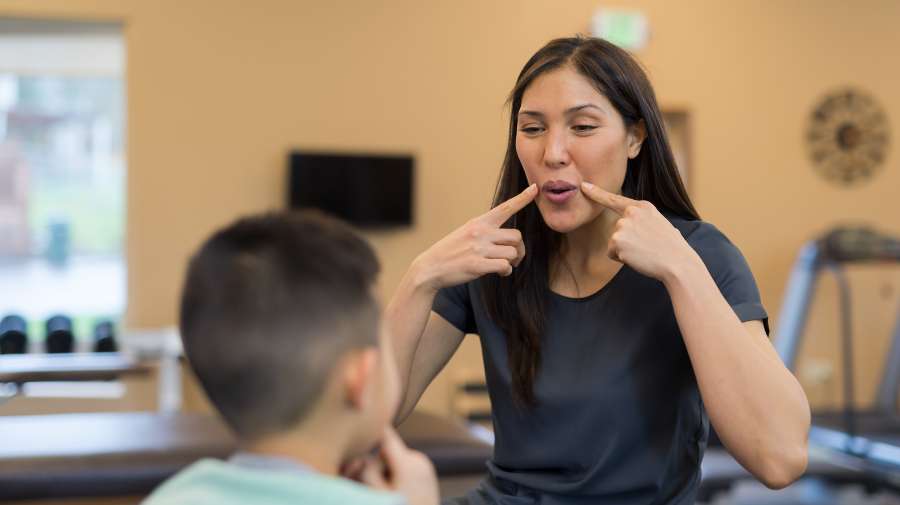Top 10 CPT codes for speech therapy

Medical billing codes can quickly become confusing — there are lots of codes to choose from, and many are quite similar. But having a thorough knowledge of procedure codes will help you run a better practice. Choosing the right CPT code to use on a claim helps ensure you get accurately reimbursed for the services you provided — and reduces the chance of time-consuming rejections that require resubmission. In this post, we examine the most common CPT codes for speech therapy that you’re likely to encounter on a regular basis in your practice.
What is a CPT code?
Current Procedural Terminology (CPT) is a set of codes that are used to describe medical, diagnostic, and surgical procedures and services. The American Medical Association created CPT codes as a standard way of describing healthcare services. A multidisciplinary panel regularly reviews and updates the codes to accurately represent developing medical advances. CPT codes are used in a variety of situations — including medical billing.
Most common CPT codes used for speech therapy
Here are ten codes most frequently used by speech therapists, along with their descriptions. While it’s important for your medical biller to have a thorough knowledge of CPT codes related to speech therapy, this list is a good place to start.
1. 31579 — Laryngoscopy, flexible or rigid telescopic, with stroboscopy
Code 31579 is used if the speech/language pathologist inserts a laryngoscope. Note that the procedure must be performed in accordance with the ASHA Code of Ethics and ASHA Training Guidelines for Laryngeal Videoendoscopy/Stroboscopy. Also, note that this code should not be used for an evaluation — instead, code 92610 should be used (as appropriate).
2. 92507 — Treatment of speech, language, voice, communication, and/or auditory processing disorder
Code 92507 is used for therapy services that pertain to auditory rehabilitation, voice prosthetics, and communication and/or cognitive impairments.
3. 92521 —Evaluation of speech fluency (e.g., stuttering, cluttering)
When using code 92521, the evaluation must provide information about:
- The patient’s fluency level with a quantitative and/or qualitative measurement and/or a measurement of speaking rate (such as SPM — syllables per minute).
- Fluency may be documented through:
- a description of severity and frequency.
- results of a commercial stuttering severity instrument.
- a description of severity and frequency, secondary characteristics, self-awareness/self-correction/perception, and types of dysfluencies.
4. 92523 — Evaluation of speech sound production (e.g., articulation, phonological process, apraxia, dysarthria); with evaluation of language comprehension and expression (e.g., receptive and expressive language)
The evaluation described by code 92523 must provide information about the patient’s speech intelligibility using quantitative and/or qualitative testing. Documentation for the patient’s abilities may include:
- using standardized test results.
- documenting the percentage of intelligibility when context is known and unknown by familiar and unfamiliar listeners.
- reporting symptoms and signs of disordered sound production.
- comparisons to developmental levels or norm-referenced data.
- using standardized tests and noting both expressive and receptive language abilities.
If you are unable to complete formal testing, you may use an estimate of language age-equivalent levels
5. 92524 — Behavioral and qualitative analysis of voice and resonance
Code 92524’s evaluation must provide the patient’s voice and resonance in a quantitative and/or qualitative measurement, including but not limited to:
- a description of the patient’s awareness of the vocal problem and phonatory behaviors.
- perceptual ratings of voice, pitch, loudness, and quality.
Note that this procedure code does not include an instrumental assessment.
6. 92526 — Treatment of swallowing dysfunction and/or oral function for feeding
An identified feeding and/or a physiological swallowing problem must be present to use code 92526. The problem must be documented using professional standards of practice such as:
- an oral mechanism exam
- current dietary restrictions
- a report on how nutrition is met
- identification of oral phase, esophageal phase, or pharyngeal-phase dysphagia
- compensation strategies used
- the level of assistance required
- a baseline of current swallowing and feeding skills not limited to signs of aspiration
7. 92605 — Evaluation for prescription of non-speech-generating augmentative and alternative communication device
Code 92605’s evaluation is for patients who need a non-speech generating augmentative and alternative communication device (AAC). Use this code for the first hour, and use code 92618 for additional time in 30-minute increments.
An AAC evaluation may include the following individualized assessments of the patient’s:
- communication skills
- communication partners
- communication demands
- sensory skills and motor skills
8. 92606 — Therapeutic services for the use of non-speech-generating augmentation and alternative communication device
Code 92606 is used when the patient has the non-speech generating augmentation and alternative communication device (AAC) and you are working on:
- modifying or programming the device for the patient.
- appropriate use of the device for communication.
Once you have set up and programmed the device, you will usually bill 92507 for ongoing language and speech treatment.
9. 92609 — Therapeutic services for the use of speech-generating device
Use code 92609 for the in-person services used to adapt the speech-generating device and to train the patient in its use.
10. 92610 — Evaluation of oral and pharyngeal swallowing function
This code is to be used for the evaluation of a patient’s swallowing and feeding ability. It may include an:
- assessment of swallowing ability using various consistencies and textures
- functional assessment of structures and muscles
- assessment of compensatory strategies and/or modifications
- observation of reflexes as well as head, neck, and postural control
- assessment of the patient’s face, lips, tongue, jaw, hard and soft palate, oropharynx, and secretion management
Becoming familiar with these codes and how they’re used will help you better know when to use them and what documentation to provide when you submit your claims. You may want to print out and keep this list handy, as it will serve as a helpful reference.






